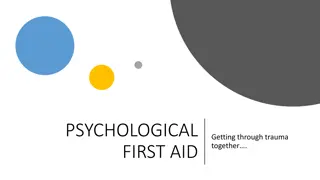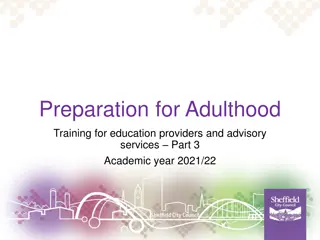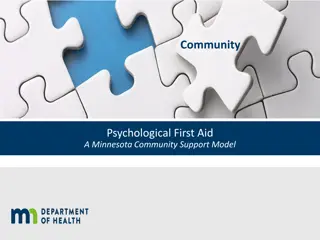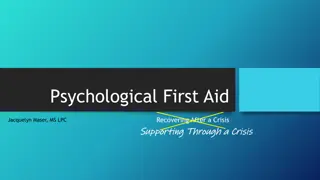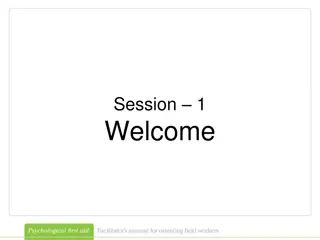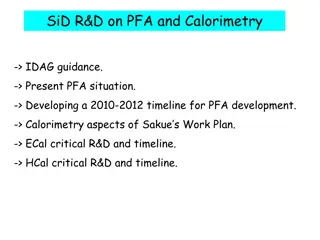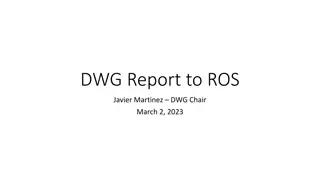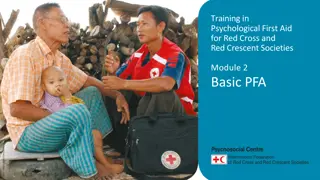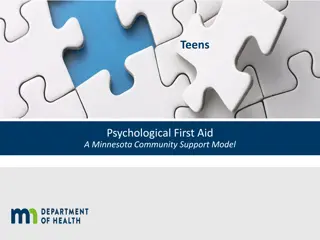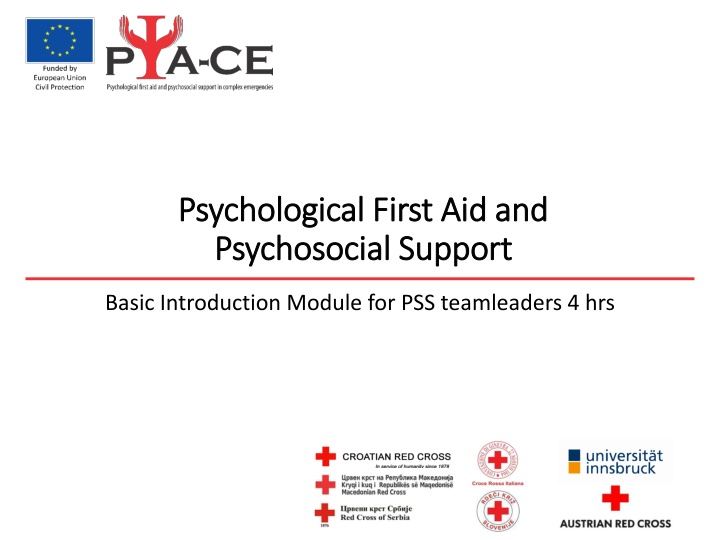
Psychosocial Support and Psychological First Aid: Training Modules Overview
Explore the comprehensive training modules designed for PSS team leaders, staff, and volunteers focusing on Psychosocial Support and Psychological First Aid. Learn about key elements, principles, steps, and interventions in providing aid during disasters and crises with real-life case examples included.
Download Presentation

Please find below an Image/Link to download the presentation.
The content on the website is provided AS IS for your information and personal use only. It may not be sold, licensed, or shared on other websites without obtaining consent from the author. If you encounter any issues during the download, it is possible that the publisher has removed the file from their server.
You are allowed to download the files provided on this website for personal or commercial use, subject to the condition that they are used lawfully. All files are the property of their respective owners.
The content on the website is provided AS IS for your information and personal use only. It may not be sold, licensed, or shared on other websites without obtaining consent from the author.
E N D
Presentation Transcript
Psychological First Aid and Psychological First Aid and Psychosocial Support Psychosocial Support Basic Introduction Module for PSS teamleaders 4 hrs
PSS/PFA for beneficiaries consists of the following parts 1. Teamleader training 1. Trainer Handbook 2. Powerpoints 2. Staff and Volunteer Training 1. Trainer Handbook 2. Powerpoints
Staff and Volunteer Training (Trainer Handbook and Powerpoints) What is Psychosocial Support? What is Psychological First Aid? The five elements of effective Psychosocial Support (Hobfoll Principles) (incl exercise, best practice) Psychological First Aid Steps (incl exercise/roleplay) Additional Material on stress reactions and how to deal with them (incl roleplay)
Teamleader Training Disasters, Mass Emergencies and Crises What is PFA/PSS? Psychosocial Triage (incl exercise) The Hobfoll Principles in Action (incl exercise) Roles and Responsibilities in disaster MHPSS (incl discussion) Intervention formats in MHPSS (incl exercise)
General General Aspects Aspects
Basic principles of social support Sphere social indicators 1 Access to information Maintain normal cultural and religious events Formal or informal schooling for children and recreational activities (safe places) Participation in concrete, purposeful activities Shelter for displaced, with the aim of keeping families and communities together
Case Example (Italy) After a large earthquake about 500 people are waiting in front of the morgue in order to be allowed in for identification procedures The PS teams establish places of worship, places where people can sit down, eat, drink, places for children and accompany the families to the viewings
Case Example (Italy) Shelters for 15000 people are established The PS teams suggest to vote for a major in each shelter, to establish places of social reunion in the shelters, and schools and kindergartens for children . Funerals are organised in a culturally appropriate manner Regular information is given to the inhabitants of the shelter on the danger of further earthquakes, the further procedures of recovery as well as injurance questions
Hobfoll Hobfoll Principles Principles
Elements of (effective) psychosocial support Hobfoll (2007) Safety Connectedness Self and collective efficacy Calm Hope
Safety Create a safe place Establish a trustful relationship Stay with them Give open and honest information
Safety: How to give information Give regular information about facts, rescue and how to proceed as well as anything else that is needed Keep it short and simple Tell the truth (you do not have to say everything but what you say must be true) Do not give too deatailled information in the beginning but let yourself be guided by the persons questions
Self and collective efficacy: Regaining control Help people to regain control Let them be active wherever possible Give them tasks they are able to fulfill Let them take their own informed decisions
Calm: Stress reduction Help the affected persons, groups, communities to gain distance to the event for some moments Re-establish daily routines and normalcy as soon as possible Children: give them possibilities to play and divert themselves
Connectedness Help the affected persons , groups, communities to connect to each other Reunite families as soon as possible Strengthen social networks Try to bring in friends/relatives who can support
Hope Help the affected persons/groups/communities to take small steps into the future Plan little steps like how and with whom to return into one s house, which music to play at the funeral etc.
Psychosocial Psychosocial Triage Triage
MHPSS Intervention Pyramid Specialized services Focused non specialized supports Community and family supports Basic services and security
Exercise Psychosocial Triage Criteria Step 1(general PFA) Degree of Exposure Degree of Closeness to directly affected (Circles of affectedness) Step 2 (Kind of MHPSS supports given-see Pyramid) Involvement Situation Stress Reactions Special Needs/Vulnerability
Exercise translate Hobfoll Principles Hobfoll principles Safety Connectedness Self and collective efficacy Calming Hope Strategies Safe places, information Family reunions, data matching Involve in decision making Normalcy/Rituals Evoke Positive Emotions, involve in recreational activities and coach for next steps
Roles Roles and and responsibilities responsibilities
The three main tasks of PFA/PSS with beneficiaries are in the beginning To decide how to best reach the affected people (see intervention formats below) To open up a communication channel between the affected people and the authorities and to allow for a dialogue To organise data management in order to allow for fast family reunions and identifications of victims
Roles and responsibilities in disasters may vary a lot between different European Countries. Common elements are subsidiarity (responsibility in the local communities) and the auxiliary role of the Red cross in Disasters. In some European Countries the Red Cross is involved in the medical and Psychosocial support during disasters and large scale emergencies, in others it is more involved in first aid and social support as well as the provision of shelters in disasters.
Specialized PSS/PFA services are often provided by several different organisations that are either spezialized in acute or mid and longterm care. The TENTS guideline therefore recommend to establish a multiorganisational and multiprofessional coordination network in preparation for emergencies/disasters (www.tents.eu)
In Emergencies PSS/PFA functions as an intermediate between the affected population and the authorities. It has the task of opening up a communication channel between the affected people (noninjured survivors, families, friends, etc.) and the authorities.
This can only be done when PSS/PFA is recognized by all stakeholders and if the respective organisations providing PFA/PSS in emergencies have good contacts to the authorities and police as well as other stakeholders. Within the organisation it is important that PFA/PSS is embedded into the command structure and crisis communication plans.
Intervention Formats Intervention Formats
Event types and Intervention formats We differentiate mainly between two event types Both can also be combined in various forms (see case example for exercise) Type 1: Mass emergencies without damage to infrastructure Type 2: Disasters with damage to infrastructure Type 1 and 2 comibinations (see exercise) 28
Event types and Intervention formats Crucial question: How can we reach the affected population best? Type 1: people come to reception centers because they need information Type 2: people have to be reached in those support structures that are given in order to provide infrastructure (evacuation center, shelter etc.) 29
Intervention format: Humanitarian Assistance Center A HAC is a focal point for the provision of information and assistance to all those affected by an emergency, and also provides support to survivors of an emergency. 31
Intervention format: Humanitarian Assistance Center The survivors include those injured from those with critical injuries requiring long-term hospitalisation to the walking wounded who may be to self-treat with basic medication and equipment at home and those not physically affected, but traumatised by the emergency, including those directly involved, as well as witnesses and local responders, families and friends. 32
Intervention format: Humanitarian Assistance Center A HAC is one part of the emergency response used for midterm support Other, more immediate sources of information and help may be provided in the first 24 hours (casualty bureau, rest centre, family and survivors reception centre) (HAC guidance, 2009) 33
Casualty Bureau Timeframe: Immediate Tasks: Initial point of contact for receiving/assessing information about victims, to: inform the investigation trace and identify people reconcile missing persons collate accurate information for dissemination to appropriate parties. Responsibility: Police. 34
Call Centre Timeframe: Immediate Tasks: a center where calls are collected from people who are missing somebody. Personal data of missing and their familes are collected and given to the casualty bureau Responsibility: Police 35
Telephone Helpline Timeframe: Immediate Tasks: a telephone line where everybody in need related to the event can call and ask for information and advice Responsibility: Organisation in charge, authorities 36
Survivors Reception Centre Timeframe: Immediate Tasks: A secure area in which survivors not requiring acute hospital treatment can be taken for short-term shelter and first aid. Evidence might also be gathered here. Responsibility: Organisation in Charge of Immediate response, Authorities. 37
Family and Friends Reception Centre Timeframe: first 12 hours Tasks: To help reunite family and friends with survivors it will provide the capacity to register, interview and provide shelter for family and friends. Responsibility: organisation in charge, authorities. Responsibility: Organisation in Charge, Authorities. 38
Rest Centre Timeframe: first 12 hours Tasks: A building designated or taken over by the local authority for temporary accommodation of evacuees/homeless survivors or relatives and friends, with overnight facilities. Responsibility: Organisation in Charge, Authorities. 39
Information Points A space where regular information can be given to the affected group, can be part of a reception center or evacuation center, can be face to face information, written information and/or digital information depending on target groups, context and resources. Most important: Honest information, secure information and establishment of a dialogue with the affected group(s) 40
Mobile Teams Mobile teams can be used for: needs assessment, vulnerability assessment, direct psychosocial support to families who have lost someone etc Mobile teams should be multiprofessional and put together from those professions that are most needed at the given moment 41
Simulation Exercise See handout


